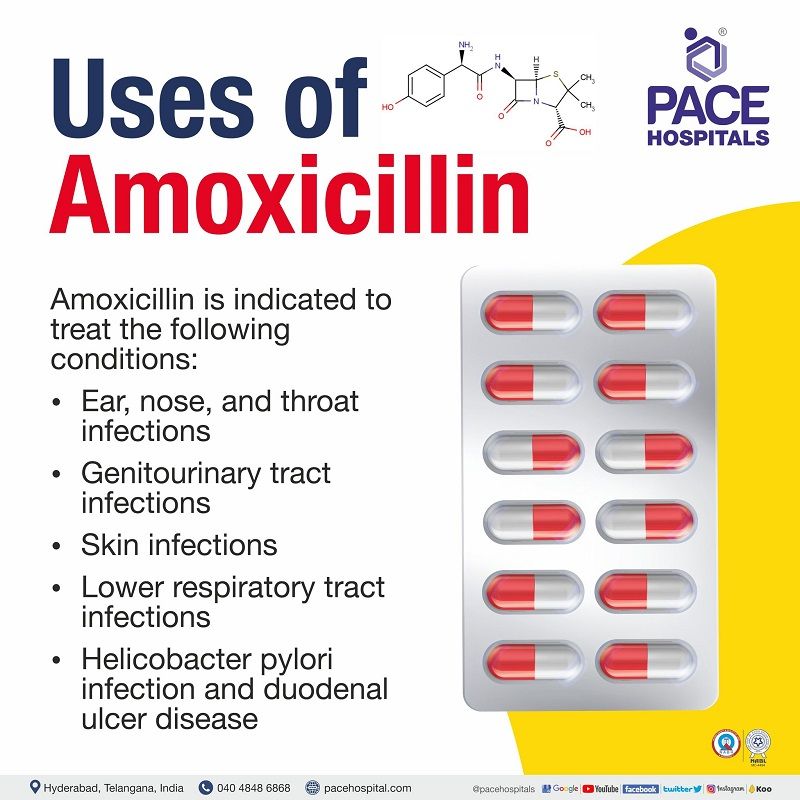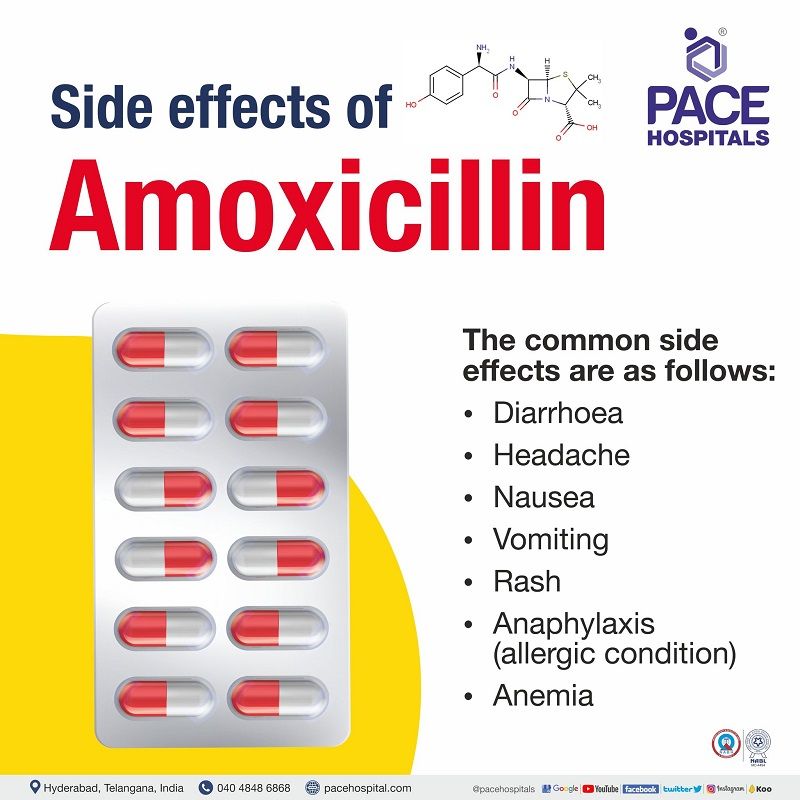Amoxicillin – Uses, Side Effects, Composition and Price
Amoxicillin is a penicillin-class antibiotic (beta-lactam antibiotic class of drugs) used to treat various ears, skin, nose, throat, genito-urinary and lower respiratory tract infections caused by gram-positive and gram-negative aerobic bacteria.
Overview of Amoxicillin
- Amoxicillin is a penicillin-class antibiotic used to treat infections which are caused by gram-positive and gram-negative aerobic bacteria.
- Amoxicillin was initially approved by the United States in 1974. It is the best effective in the treatment of drug-resistant bacteria.
- Amoxicillin is used to treat ear, skin, nose, throat, genito-urinary and lower respiratory tract infections.
- Amoxicillin is available in various forms, such as capsules, tablets, chewable tablets, powder for oral suspension and paediatric drops for oral suspension. It is also available in injection forms with other combinational drugs, especially indicated to treat a few specific infections.
Amoxicillin uses
Amoxicillin and potassium clavulanate tablets uses are as follows:
- Amoxicillin / Clavulanic acid is used for the treatment of susceptible bacterial infections of the skin, genitourinary tract, ear, nose, and throat.
- Acute bacterial sinusitis, community-acquired pneumonia, lower respiratory tract infections, acute bacterial otitis media, skin infections, and urinary tract infections are treated with a combination of amoxicillin and clavulanate potassium.
Amoxicillin and potassium clavulanate tablets IP uses in combinational therapy are as follows:
- Omeprazole and amoxicillin combination is used to treat Helicobacter pylori (H. Pylori) infection.
- To treat H. pylori infection in adults, amoxicillin is used with vonoprazan and clarithromycin as co-packaged triple therapy or with vonoprazan as co-packaged dual therapy.

General considerations to follow while taking Amoxicillin
- Amoxicillin clavulanate may be taken with or without food every 8 or 12 hours, depending on the type of condition and strength of the product, as prescribed by the physician.
- Amoxicillin should be taken only for bacterial infections and not for viral infections (e.g., the common cold).
- Using amoxicillin in the absence of a bacterial infection or as a prophylactic administration leads to the development of drug-resistant bacteria.
- In the case of suspension, shake well before use so that the drug can be mixed with formula and water. To wet the powder, add about one-third of the required quantity of water (as per directions) for reconstitution and shake well. Add the remaining water and shake firmly one more time.
- Avoid administering the drug if any hyper reaction is seen.
- Take it at regular intervals daily to get a better result.
- Do not take two doses at the same time, as it leads to adverse events.
- In case of a missed dose (due to forgetfulness etc.), the next dose must be taken immediately as and when it is remembered.
- In case of a missed dose (due to forgetfulness etc.), it is better to go for the next dose if there is less time gap between the previous and next schedule.
- Follow the treatment chart as directed by the physician.
Amoxicillin mechanism of action
Amoxicillin shows a bactericidal (kills microorganisms) effect against susceptible organisms (bacteria that are unable to grow in the presence of the drug) during their stage of active multiplication. Amoxicillin mode of action is similar to ampicillin, and thus it works by preventing the synthesis of the mucopeptide (a protein responsible for the growth of bacteria) present in the cell wall, which in turn leads to the death of the bacteria.
Amoxicillin indications
Amoxicillin is indicated for:
- Isolates of Streptococcus and Staphylococcus species that cause infections of the ear, nose, and throat.
- Infections of the genitourinary tract due to isolates of Escherichia coli (E.coli), Proteus mirabilis, or Enterococcus faecalis.
- Infections of the skin due to susceptible isolates of Streptococcus species, Staphylococcus species, or E. coli.
- Infections of the lower respiratory tract (LRTI) due to susceptible isolates of Streptococcus species, S. pneumoniae, Staphylococcus species, or Haemophilus influenzae.
- Helicobacter pylori infection and duodenal ulcer disease are treated in combination with clarithromycin and lansoprazole.
Amoxicillin dosage
Dosage forms & strengths of amoxicillin:
- 250 mg, 500 mg (Amoxicillin capsules)
- 500 mg, 875 mg (Amoxicillin tablet)
- 125 mg/5ml, 200 mg/5 ml, 250 mg/5ml, and 400 mg/5ml (oral solutions); each 5ml of reconstituted solution contains 125 mg, 200 mg, 250 mg, and 400 mg of the drug, respectively.
- 250 mg, 500 mg, 1g (injections).
Amoxicillin dosage for adults:
Ear/nose/throat/skin infection
- Mild/moderate condition - 500 mg for every 12 hours or 250 mg for every 8 hours
- Severe condition - 875 mg for every 12 hours or 500 mg for every 8 hours
Lower respiratory tract infection
- Mild/ moderate condition - 875 mg for every 12 hours or 500 mg for every 8 hours
- Severe condition - 875 mg every 12 hours or 500 mg every 8 hours
Helicobacter pylori (H. Pylori) infection
- Moderate and severe condition - Triple therapy: 1g amoxicillin + 500 mg clarithromycin + 30 mg lansoprazole
H. Pylori infection and duodenal ulcer disease
- Moderate and severe condition - Double therapy: 1g amoxicillin + 30 mg lansoprazole
Amoxicillin dose for paediatrics/children > 3 Months:
Ear/ nose /throat/skin infection
- Mild/ moderate condition - 25 mg/kg/day in divided doses for every 12 hours or 20 mg/kg/day in divided doses for every 8 hours
- Severe condition - 45 mg/kg/day in divided doses for every 12 hours or 40 mg/kg/day in divided doses for every 8 hours
Lower respiratory tract (LRT) infection
- Mild/ moderate condition - 45 mg/kg/day in divided doses for every 12 hours or 40 mg/kg/day in divided doses
- Severe condition - 45 mg/kg/day in divided doses for every 12 hours or 40 mg/kg/day in divided doses every 8 hours
Note: The above children dose is recommended for only the patients whose weight is less than 40kgs, but for the child patients with a weight more than 40kgs, the usual adult dose is recommended.
Amoxicillin dose in neonates and infants aged ≤ 12 weeks (≤ 3 months):
- 30 mg/kg/day orally every 12th hourly interval for 2 to 3 days.
Amoxicillin dose for renal impairment patients:
- Renal impairment patients with glomerular filtration rate < 30 mL/min should not receive an 875 mg dose. Instead, they are administered with 500 mg or 250 mg every 12 hours based on the severity of the condition.
- Renal impairment patients with glomerular filtration rate <10 mL/min are administered with amoxicillin and potassium clavulanate tablets IP of 500 mg or 250 mg every 24 hours based on the severity of the condition.
- Haemodialysis patients are administered with amoxicillin 500 mg or amoxicillin 250 mg every 24 hours based on the severity of the condition. (Note: haemodialysis patients should receive an additional dose of amoxicillin during and after the completion of dialysis).
- There is currently no dosing schedule for renal impairment patients in children and paediatrics.
Disclaimer: The dosing information (doses, dosages frequency, and everything connected) provided here is compiled from accurate, trusted sources. Nevertheless, we can neither guarantee its accuracy nor shall be responsible for any of its updation. We do not encourage self-medication. The treating physician retains the medical discretion of administering or discontinuing the drug.

Amoxicillin side effects
Generally, Amoxicillin is a common antibiotic that is used to treat a variety of bacterial infections and doesn’t cause any side effects. However, in some cases, these are some common side effects experienced by adults and children.
Common side effects of Amoxicillin:
- Diarrhoea (loose stools)
- Headache
- Nausea (vomiting sensation)
- Vomiting
- Rash
- Anaphylaxis (allergic condition)
- Anaemia (lack of blood)
Serious side effects of Amoxicillin:
- Thrombocytopenia (deficiency of platelets)
- Convulsions (involuntary movements of body muscles)
- Cholestatic jaundice (jaundice caused due to the stoppage of bile from the liver)
- Meningitis (inflammation of brain and spinal membranes)
- Vasculitis (inflammation of blood vessels)
The following side effects were caused when amoxicillin is indicated with a combination of clarithromycin and lansoprazole in conditions like H. pylori and duodenal ulcer diseases.
- Diarrhoea
- Headache
- Taste perversion (altered taste)
Postmarketing side effects of Amoxicillin:
- Skin/nails: mucocutaneous candidiasis (fungal infection to skin and nails)
- Gastrointestinal tract: black hairy tongue, haemorrhagic colitis (illness-causing abdominal pain and watery stools)
- Liver: elevation of AST (aspartate transaminase) /ALT (alanine transaminase) levels (indicators of liver disease), cholestatic jaundice, cytolytic hepatitis (liver injury where liver cell death takes place)
- Renal: crystalluria (crystals in urine)
- Blood and lymphatic system: haemolytic anaemia, thrombocytopenia (deficiency of platelets)
- Central nervous system: convulsions (involuntary movements of body muscles), anxiety, dizziness (feeling lightheaded)
Note: If you experience any serious side effects as mentioned above or with any serious reaction, then immediately seek medical attention by visiting the hospital or physician.
Amoxicillin contraindications
Amoxicillin is contraindicated in patients who are:
- Allergic to penicillin’s
- Experienced with anaphylactic reactions (life-threatening reactions)

Effect of Amoxicillin in pregnancy, breastfeeding, and elderly people
Amoxicillin in pregnancy:
No studies were performed on pregnant women, so there is no clear evidence regarding amoxicillin usage in pregnant women. Studies have been performed only in rats and mice; hence it cannot resemble humans; thereby, amoxicillin could be administered to pregnant women if needed.
Amoxicillin in breastfeeding:
Studies have shown that amoxicillin is ejected in breastmilk, it may cause sensitisation in infants, and thereby caution is needed when amoxicillin is administered to lactating women.
Amoxicillin in geriatric (age >65 years):
Elderly patients need to be monitored for renal function when amoxicillin is administered.
Amoxicillin interactions with other drugs
A drug interaction is defined as a reaction between two or more drugs, food, or supplements leading to the undesired reaction.
A wide range of effects could be expected when amoxicillin is given in combination with the following drugs:
- Probenecid: on coadministration, it leads to increased blood levels of amoxicillin and decreases renal tubular secretion.
- Anti coagulants: alteration may take place in prothrombin time; keen monitoring is needed.
- Allopurinol: on coadministration, it may cause rashes.
- Oral contraceptives: affects the gut flora, which in turn lowers the oestrogen reabsorption.
- Bacillus Calmette Guerin (BCG) vaccine: amoxicillin interferes with the anti-tumour activity of the BCG vaccine and reduces its effectiveness.
- Cholera vaccine: amoxicillin may interfere with the immunological response of the vaccine and diminishes its activity.
- Typhoid vaccine: amoxicillin may interfere with the immunological response of the vaccine and diminishes its activity.
- Methotrexate: on coadministration, it may elevate serum methotrexate concentrations and leads to severe adverse effects.
Note: On discussion with your physician, he/she may advise you to avoid or take an alternative drug or maintain a time gap if any of the above-prescribed drugs are to be taken together.
Amoxicillin price in India
The price of amoxicillin in India varies depending on the brand, dosage, and form of the medication. However, it is generally a very affordable medication. Here are some of the brands of amoxicillin in India and their prices:
| Product | Manufacturer/Marketer | Maximum Retail Price (MRP) |
|---|---|---|
| Amoxil 500 mg | Zydus Healthcare Ltd | ₹ 76 for each strip (each strip contains 10 capsules) |
| Novamox 500 mg | Cipla Ltd | ₹ 110.20 for each strip (each strip contains 15 capsules) |
| Mox 500 mg | Sun Pharmaceutical Industries Ltd | ₹ 123.48 for each strip (each strip contains 15 capsules) |
| Cipmox 500 mg | Cipla Ltd | ₹ 110.20 for each strip (each strip contains 15 capsules) |
| Amoxybid 500 mg | GlaxoSmithKline Pharmaceuticals Ltd | ₹ 34.29 for each strip (each strip contains 6 capsules) |
| Amoxypen 500 mg | Invision Medi Sciences Pvt Ltd | ₹ 72.50 for each strip (each strip contains 10 capsules) |
| Ampifix 500 mg | Intra Labs India Pvt Ltd. | ₹ 60.90 for each strip (each strip contains 10 capsules) |
| Blumox 500 mg | Blue Cross Laboratories Ltd | ₹ 64 for each strip (each strip contains 10 capsules) |
| Cidomex 500 mg | Sanofi Aventis Pharma India | ₹ 33.78 for each strip (each strip contains 6 capsules) |
| Epiclox 500 mg | Epitome Life Sciences | ₹ 69 for each strip (each strip contains 10 capsules) |
| Almox 500 mg | Alkem Laboratories Ltd | ₹ 80.26 for each strip (each strip contains 10 capsules) |
| Evoxil 500 mg | Leeford Healthcare Ltd | ₹ 78 for each strip (each strip contains 10 capsules) |
Share on
Request an appointment
Fill in the appointment form or call us instantly to book a confirmed appointment with our super specialist at 04048486868













